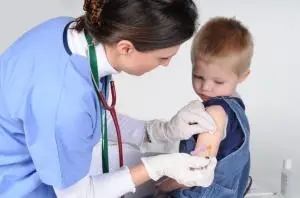There are several common communicable diseases contracted by young children. Learning the proper precautions to prevent the contraction of these illnesses, and learning to recognize their symptoms early is critical in preventing the spread of disease and keeping our younger population healthy. Here at United Medical Education we work hard to educate the general population on proper hygiene and health practices.
Current illness prevention precautions have proven quite successful if implemented. While some common communicable diseases found in children still exist, modern medicine has proven the ability to practically eliminate others or greatly alleviate their symptoms. This article will serve as a guide and resource to parents and others who have regular interaction with young children to help prevent common communicable diseases during childhood.
Who Should Get Involved
This guide is primarily for parents but it can also serve as a valuable resource for those who work closely with children. This includes individuals employed at a daycare, preschool, hospital, camping facility, or other institution centered around the development of young children. Every adult plays a role in protecting our future generation and keeping them healthy. Even those individuals that don’t have regular contact with small children should be active and informed members in their communities and help in the recognition and treatment of common communicable diseases early on. We also provide bloodborne pathogens training for those needing certification.
Proper Prevention Practices For Common Illnesses
Hand Washing:
One of the most important illness prevention practices is to have children wash their hands frequently. After having contact with a populated area or other individuals that may be infected with a common illness a child should wash their hands using soap and water, gently rubbing their hands together. Effective scrubbing of the hands with water is the most crucial element in removing disease causing bacteria. Adding soap while washing hands has proven to make hand washing even more successful at removing the bacteria. The Center for Disease Control (CDC) also found that washing hands for a minimum of 20 seconds proved the most efficient. If the child is unable to wash their hands, the use of alcohol based hand sanitizer has proven helpful in eliminating much of the disease causing bacteria.
Covering Coughs & Sneezes:
Another important practice to prevent the spread of common childhood illnesses is to cover the child’s mouth and nose with a tissue when they cough or sneeze. Having a disposable tissue is preferred but may not be practical in all situations. In situations that a tissue is not available or the child is not compliant, teaching them to cough or sneeze into their inner arm, at the point of the elbow, is also helpful. Coughing into the inner arm, at the point of the elbow, is much more effective at preventing the spread of disease than the age old practice of covering the mouth and nose using the hands. This is because the child’s hands, once made dirty, are not commonly cleaned prior to making contact with shared items. The use of face masks have also proven effective, especially with children who fail to regularly cover their mouth properly using a tissue or their inner arm.
Timely Vaccinations:
Another common and important illness prevention practice is the immunization of a child at the appropriate ages. Many diseases have become nearly extinct because of routine immunizations, greatly improving the overall health of our younger population. Below you will find a chart with specific vaccinations that are available for children and young adults. This chart also tells at what ages children should receive each specific vaccination to help prevent the spread of disease.
Awareness of Common Symptoms
Recognizing symptoms early on is crucial to successfully prevent the spread of childhood illnesses. Parents should always be aware of their child’s routine behaviors, activity level and temperature. While symptoms may help indicate the contraction of an illness, it may be very difficult to diagnose the illness simply by symptoms alone. For this reason it is important that children regularly visit their healthcare provider when significant health changes are noticed. Below is a list of some, but not all, of the symptoms that are associated with common childhood illnesses.
Common Childhood Illness’ Symptoms:
- Fever
- Headache
- Malaise (tired)
- Diarrhea
- Nausea and vomiting
- Rash
- Sore throat
- cough
- Swollen lymph glands
- Excessive drooling (in young children)
- Abdominal pain
While some of these symptoms overlap with those experienced with the common cold or flu, they may indicate a more severe illness and should be evaluated by a professional healthcare provider if they persist or progress in severity. If a child is experiencing any of these symptoms it is important that they refrain from having regular contact with other individuals besides their caretaker until diagnosis, treatment, and recovery are completed. Below is a list of other resources that give a more complete description of common symptoms and the diseases with which they are associated.
Summary
Today, parents and their neighbors have a wide range of resources to help in keeping the younger population safe and healthy. Because of medical interventions and with the advent of vaccinations more than a dozen diseases, some of which were often fatal, are at their lowest levels in history. Each person doing their part is critical in continuing this progress in the health of young children. Taking early action may mean the difference between saving a life and preventing the spread of disease.
Other Valuable Resources:


